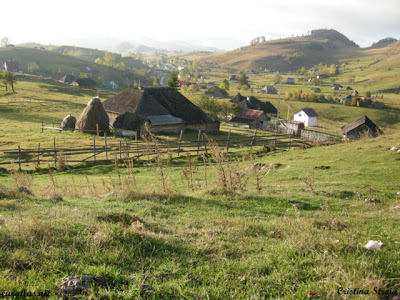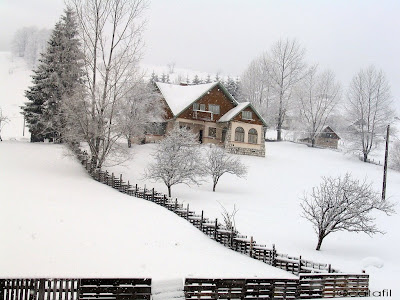Sirnea is located in the Bran Rucar Pass near Brasov. It is an area rich in history. It is where the The Battle of Călugăreni took place and it was one of the most important battles in the history of mediaeval Romania. It took place on 23 August (13 August on old style calendar) 1595 between the Wallachian army led by Michael the Brave and the Ottoman army led by Sinan Pasha.
The whole Ottoman force was estimated to have between 70.000 and 180.000 troops. According to a report written by the Spanish ambassador only 20.000 Ottomans (who were an advanced detachment) took part in the battle, against 10.000 Wallachians.
Michael the Brave had in total about 16,000 and 12 large field canons, with Transylvanian, Hungarian troops, Serbian and Bulgarian haiduks under Stephen Bocskay and Sigismund Báthory. Because he had smaller forces, Michael the Brave chose a terrain that would negate the Ottoman's numeric superiority. South of the village of Călugăreni, where the Câlniştea river flows into Neajlov river, the terrain is a muddy marsh, with forests around. A narrow bridge over the Neajlov river was a mandatory pass point. The battle had three different phases.
First Phase Of The Battle
The day of 23 August 1595 started with probing cavalry attacks. The Wallachian cavalry surprised the Ottoman cavalry in front of the village and pushed it over the Neajlov river. Michael the Brave positioned himself with 10.000 troops and 10 canons north of the Neajlov river and south of the village. The Hungarian commander Albert Király was in charge of the reserve, 6.000 strong (including the Hungarian (Székely) troops sent by the ruler of Transylvania, and the Hungarians, Serbs, and Bulgarians as well as the cossack mercenaries. The reserve was positioned rather far, north-west of the village, to stop any possible attack from the direction of the village of Singureni
After the cavalry skirmish, Sinan Pasha send forward a force 12.000 strong. Michael the Brave let the force cross the river and then, after a strong bombardment, attacked fiercely pushing this force back over the river. First phase of the battle ended favorably for the Wallachians.
Second Phase Of The Battle
The second phase of the battle started at noon, when Sinan Pasha launched an attack with all the forces he had at that moment. Janissaries made a frontal attack over the bridge while other forces made a double flanking maneuver (Mehmet Satîrgi Pasha in the east and Hasan Pasha (beilerbeg of Rumelia) in the west). Janissaries attacked not only on the bridge, but also used logs and planks to help them cross the marsh. Initially their attack was stopped, but Ottoman cavalry managed to cross the river via a ford in the east and threatened the Wallachian left wing. Michael the Brave retreated, abandoning all his canons. He rallied his troops north of the village where he stopped the Ottoman advance. Second phase of the battle ended favorably for Ottomans.
Third Phase Of The Battle
The third and last phase of the battle took place in the afternoon of the day and started with a strong frontal Wallachian attack, led by Michael the Brave.
Captain Cocea had just returned from a scouting mission with 400 cavalry and his fresh forces were used in this attack in a flanking maneuver. Mehmet Satîrgi Pasha’s troops were pushed into the Janissaries and the Ottoman forces were crowded in a narrow space north of the Neajlov river.
The Wallachian counterattack reached the bridge and the canons were retaken and used to inflict many casualties to the Ottomans. Sinan Pasha tried to restore the situation by advancing with his guards, but the Ottoman forces went in disarray when captain Cocea’s cavalry attacked them in the rear and also the Ottoman camp that was near the Hulubeşti village.
In the disorganised retreat, Sinan Pasha was thrown from his horse in the marsh, but saved by one of his slaves. The Wallachians couldn’t pursue the fleeing Ottomans because Hasan Pasha appeared on their right flank. Michael the Brave turned against Hasan Pasha and routed his forces.
Aftermath of the battle
The casualties are estimated at least 1,000 men lost by the Wallachians while the Ottoman casualties were about between 10,000 and 15,000. Michael the Brave knew that he was greatly outnumbered, and during the night he retreated north. He abandoned both Bucharest and Târgovişte, stopping at the winter camp in Stoieneşti, near Bran-Rucăr pass.
Sinan Pasha captured Bucharest and left there Mehmed Pasha with 10.000 troops, then captured Târgovişte where left another 1.500 troops and 30 canons. The bulk of the Ottoman army advanced to Stoieneşti, where they took positions in front of the Wallachian army, but they didn’t attack.
On 6 September, the Transylvania ruler, Sigismund Bathory, arrived with around 7.500 cavalry to support Michael the Brave. Early October another 1.500 troops from the Hasburg empire and 300 cavalry from Toscana arrived. These combined forces attacked the Ottomans and defeated them at Târgovişte (18 Octomber), Bucharest (22 October), and Giurgiu (26 October).
The whole Ottoman force was estimated to have between 70.000 and 180.000 troops. According to a report written by the Spanish ambassador only 20.000 Ottomans (who were an advanced detachment) took part in the battle, against 10.000 Wallachians.
Michael the Brave had in total about 16,000 and 12 large field canons, with Transylvanian, Hungarian troops, Serbian and Bulgarian haiduks under Stephen Bocskay and Sigismund Báthory. Because he had smaller forces, Michael the Brave chose a terrain that would negate the Ottoman's numeric superiority. South of the village of Călugăreni, where the Câlniştea river flows into Neajlov river, the terrain is a muddy marsh, with forests around. A narrow bridge over the Neajlov river was a mandatory pass point. The battle had three different phases.
First Phase Of The Battle
The day of 23 August 1595 started with probing cavalry attacks. The Wallachian cavalry surprised the Ottoman cavalry in front of the village and pushed it over the Neajlov river. Michael the Brave positioned himself with 10.000 troops and 10 canons north of the Neajlov river and south of the village. The Hungarian commander Albert Király was in charge of the reserve, 6.000 strong (including the Hungarian (Székely) troops sent by the ruler of Transylvania, and the Hungarians, Serbs, and Bulgarians as well as the cossack mercenaries. The reserve was positioned rather far, north-west of the village, to stop any possible attack from the direction of the village of Singureni
After the cavalry skirmish, Sinan Pasha send forward a force 12.000 strong. Michael the Brave let the force cross the river and then, after a strong bombardment, attacked fiercely pushing this force back over the river. First phase of the battle ended favorably for the Wallachians.
Second Phase Of The Battle
The second phase of the battle started at noon, when Sinan Pasha launched an attack with all the forces he had at that moment. Janissaries made a frontal attack over the bridge while other forces made a double flanking maneuver (Mehmet Satîrgi Pasha in the east and Hasan Pasha (beilerbeg of Rumelia) in the west). Janissaries attacked not only on the bridge, but also used logs and planks to help them cross the marsh. Initially their attack was stopped, but Ottoman cavalry managed to cross the river via a ford in the east and threatened the Wallachian left wing. Michael the Brave retreated, abandoning all his canons. He rallied his troops north of the village where he stopped the Ottoman advance. Second phase of the battle ended favorably for Ottomans.
Third Phase Of The Battle
The third and last phase of the battle took place in the afternoon of the day and started with a strong frontal Wallachian attack, led by Michael the Brave.
Captain Cocea had just returned from a scouting mission with 400 cavalry and his fresh forces were used in this attack in a flanking maneuver. Mehmet Satîrgi Pasha’s troops were pushed into the Janissaries and the Ottoman forces were crowded in a narrow space north of the Neajlov river.
The Wallachian counterattack reached the bridge and the canons were retaken and used to inflict many casualties to the Ottomans. Sinan Pasha tried to restore the situation by advancing with his guards, but the Ottoman forces went in disarray when captain Cocea’s cavalry attacked them in the rear and also the Ottoman camp that was near the Hulubeşti village.
In the disorganised retreat, Sinan Pasha was thrown from his horse in the marsh, but saved by one of his slaves. The Wallachians couldn’t pursue the fleeing Ottomans because Hasan Pasha appeared on their right flank. Michael the Brave turned against Hasan Pasha and routed his forces.
Aftermath of the battle
The casualties are estimated at least 1,000 men lost by the Wallachians while the Ottoman casualties were about between 10,000 and 15,000. Michael the Brave knew that he was greatly outnumbered, and during the night he retreated north. He abandoned both Bucharest and Târgovişte, stopping at the winter camp in Stoieneşti, near Bran-Rucăr pass.
Sinan Pasha captured Bucharest and left there Mehmed Pasha with 10.000 troops, then captured Târgovişte where left another 1.500 troops and 30 canons. The bulk of the Ottoman army advanced to Stoieneşti, where they took positions in front of the Wallachian army, but they didn’t attack.
On 6 September, the Transylvania ruler, Sigismund Bathory, arrived with around 7.500 cavalry to support Michael the Brave. Early October another 1.500 troops from the Hasburg empire and 300 cavalry from Toscana arrived. These combined forces attacked the Ottomans and defeated them at Târgovişte (18 Octomber), Bucharest (22 October), and Giurgiu (26 October).
Subscribe to:
Post Comments (Atom)









0 comments: